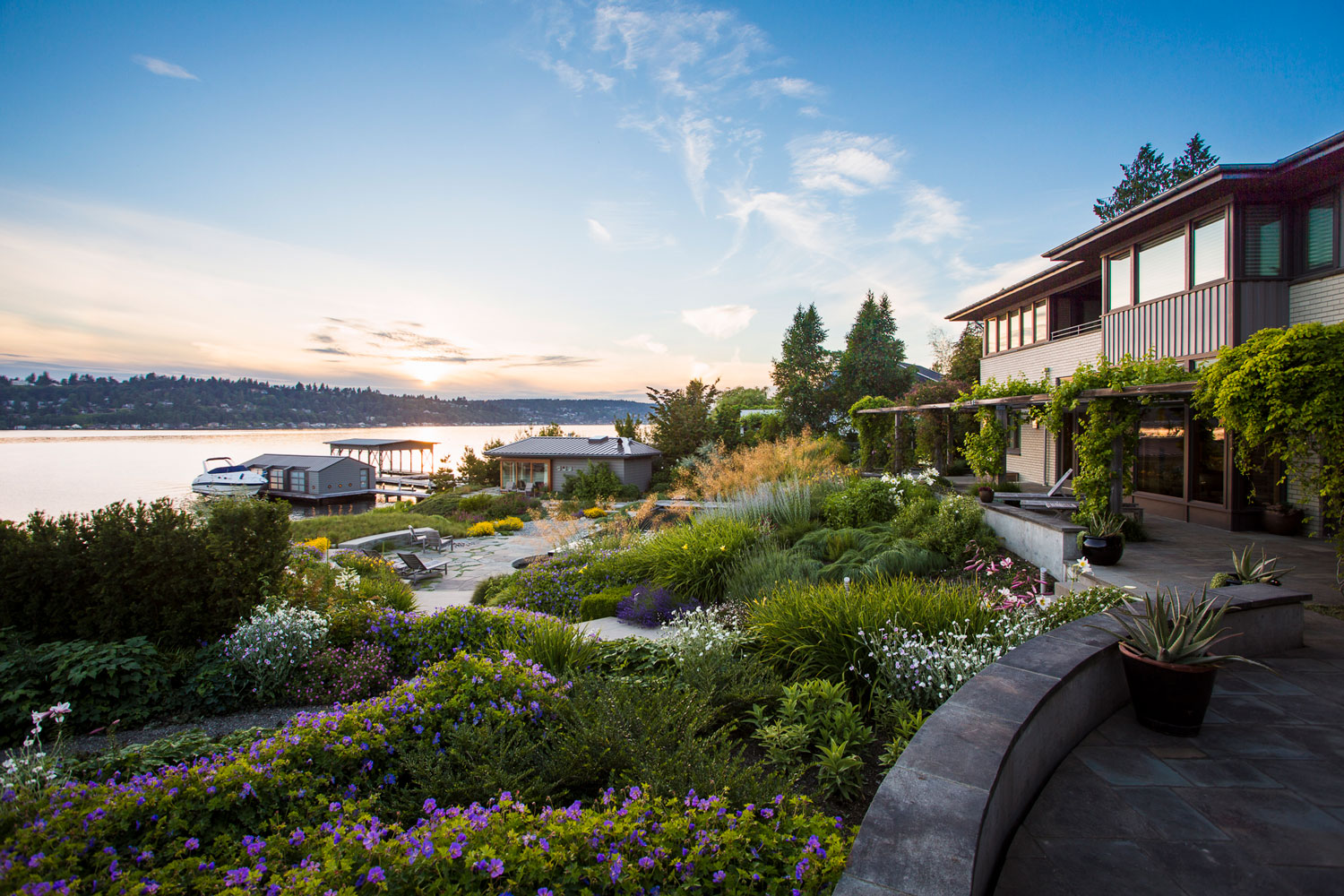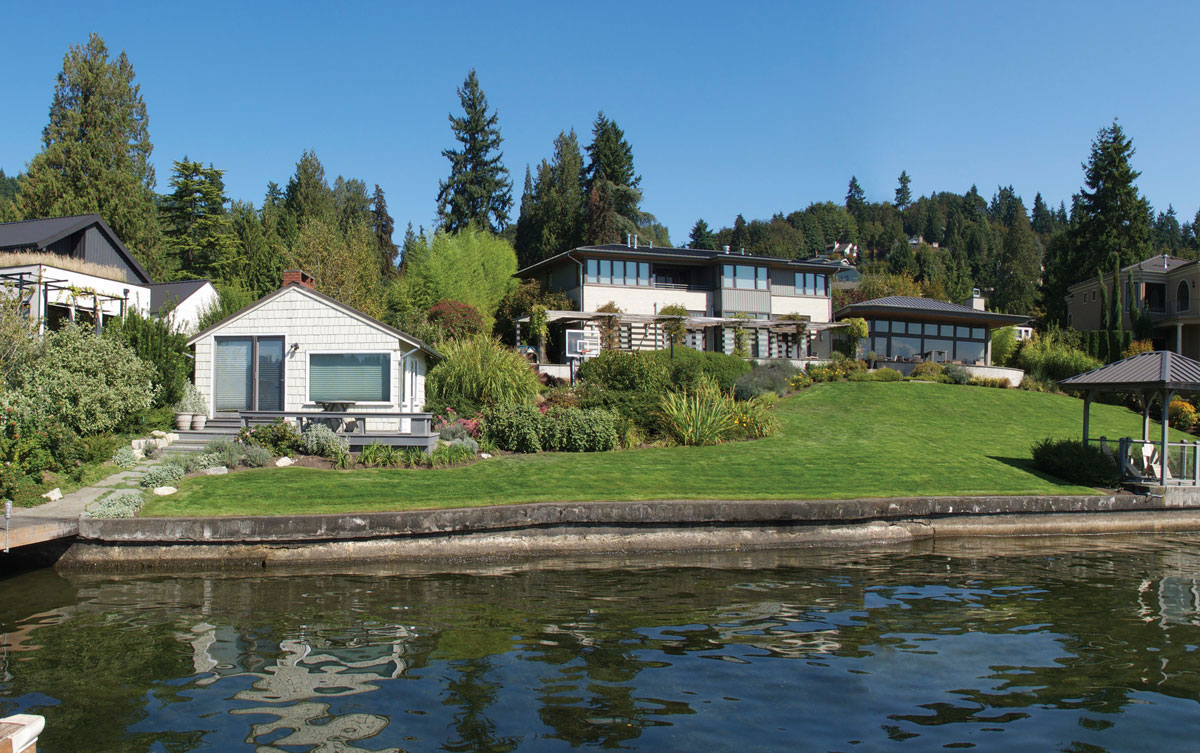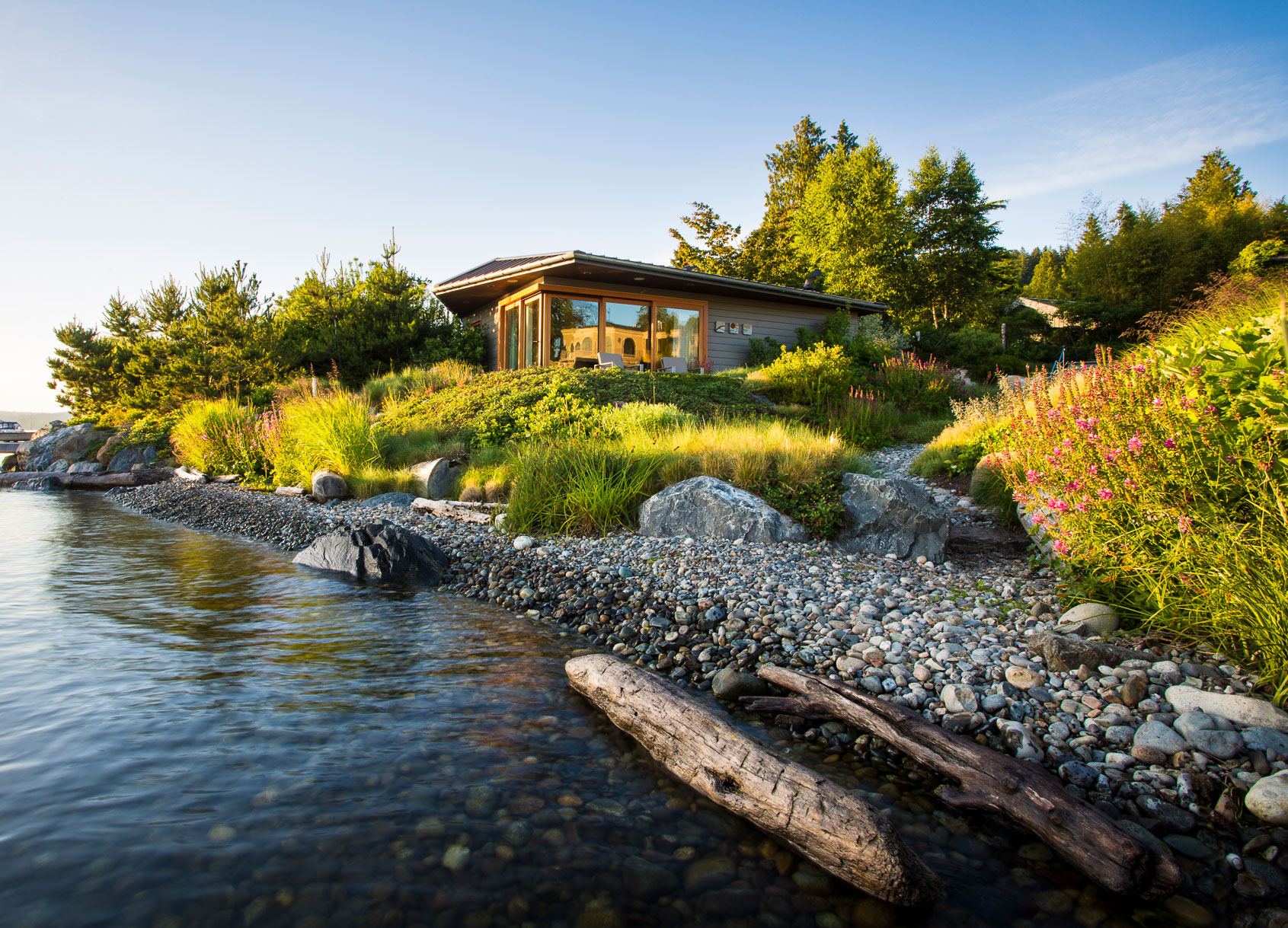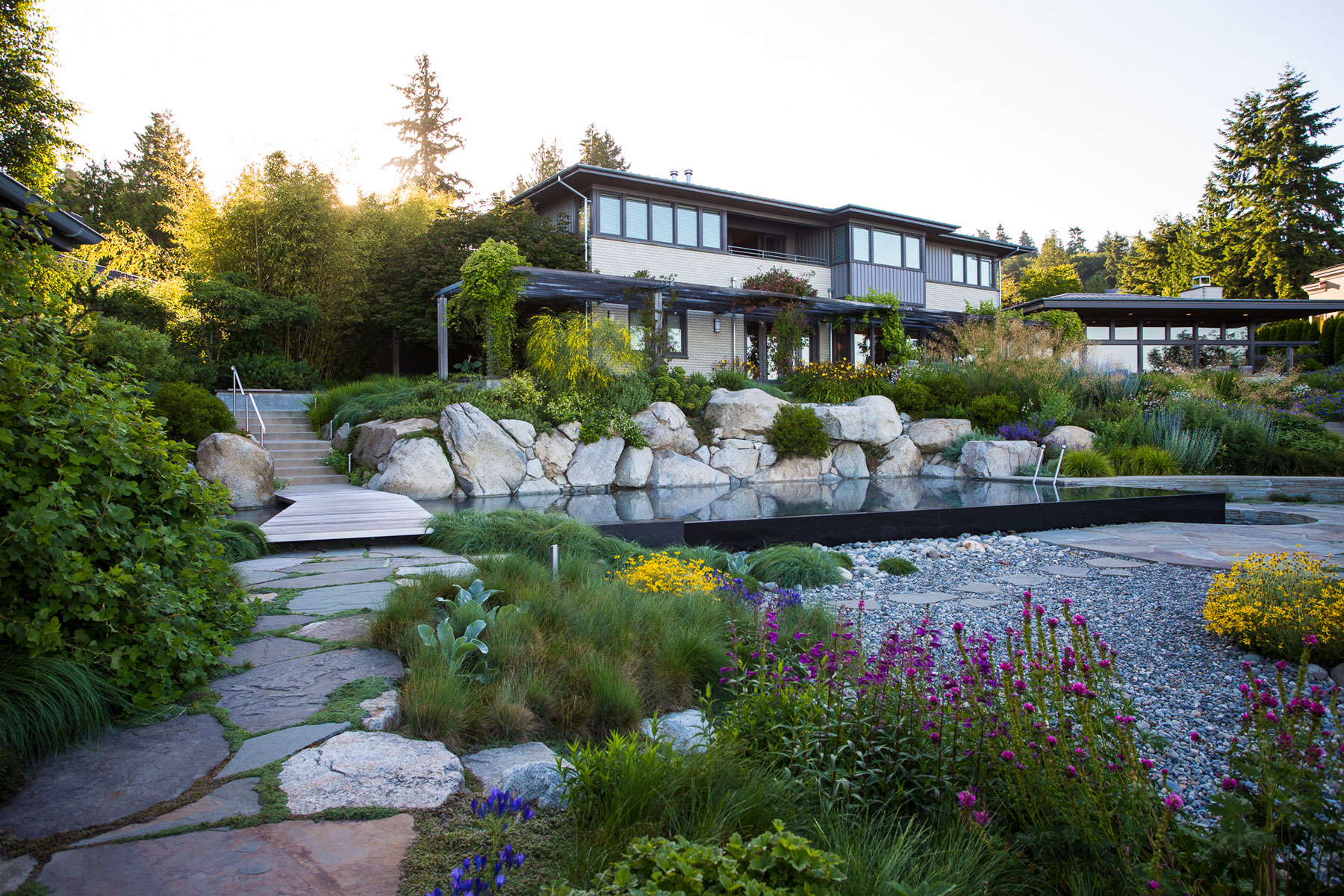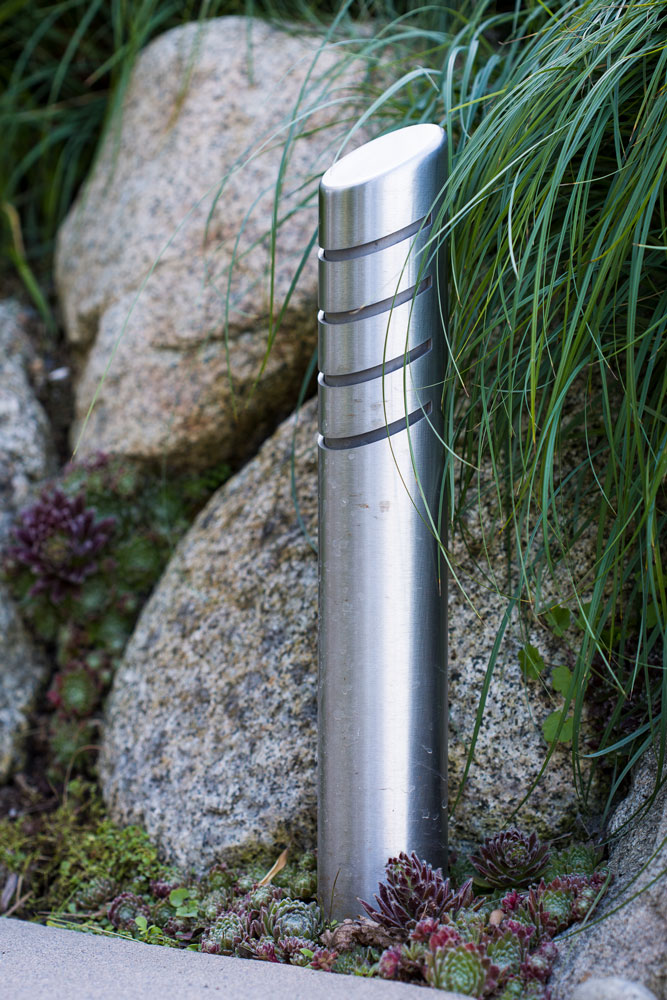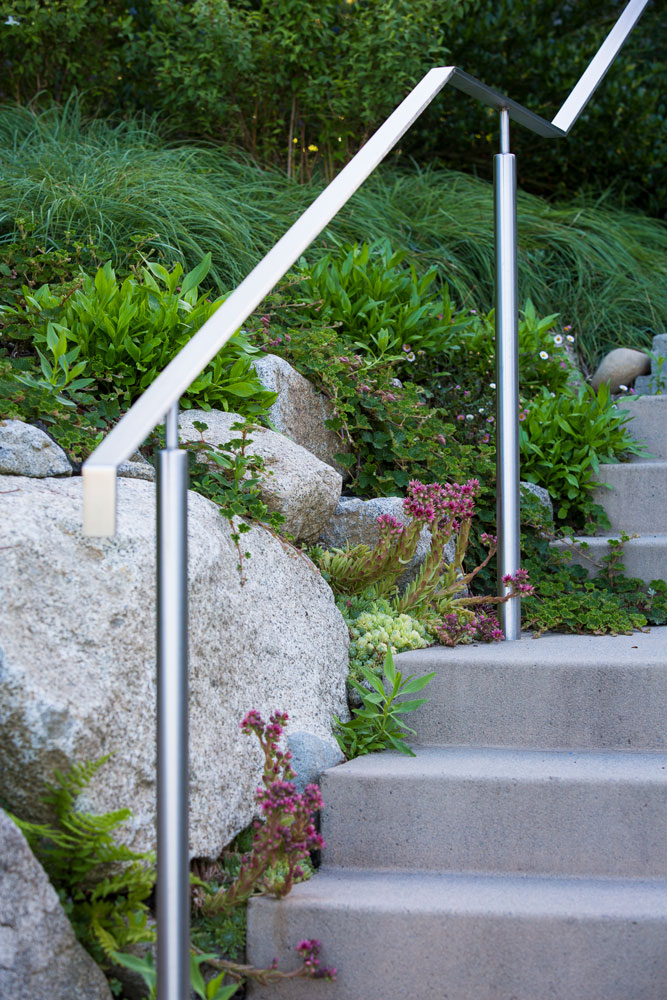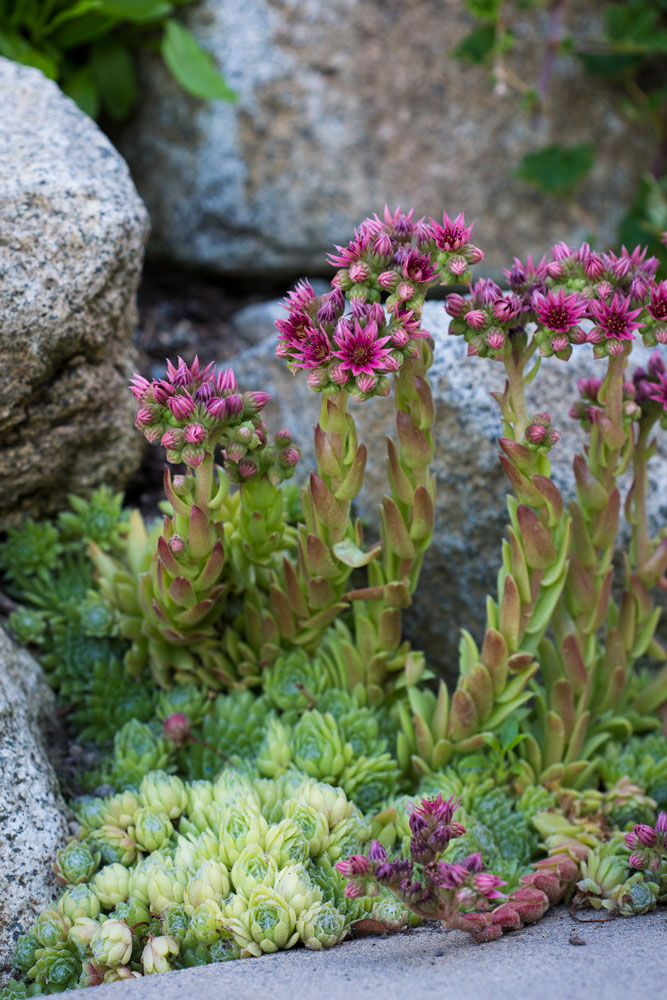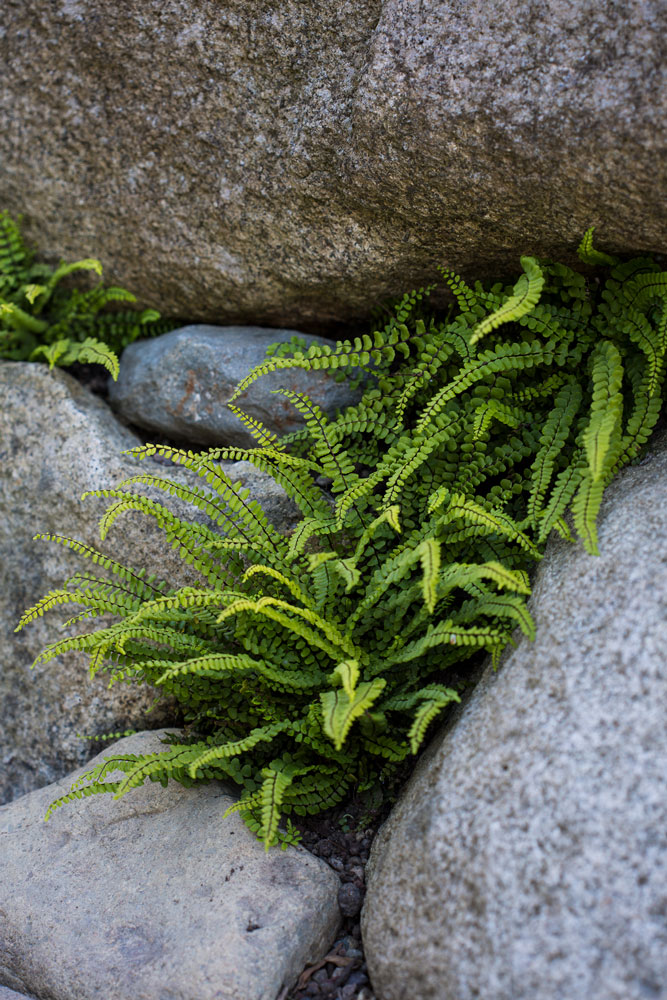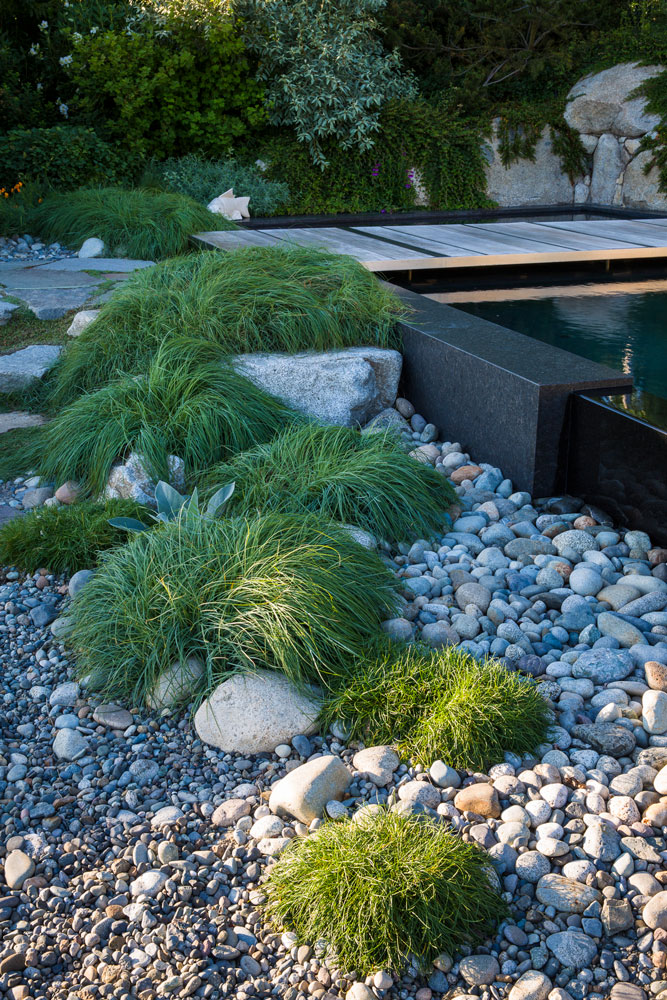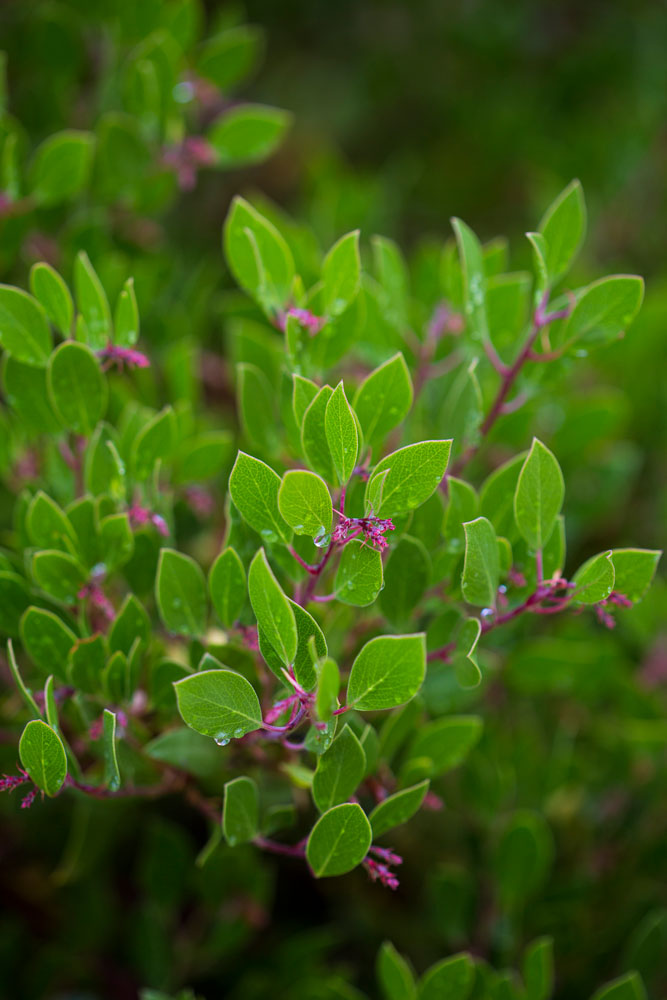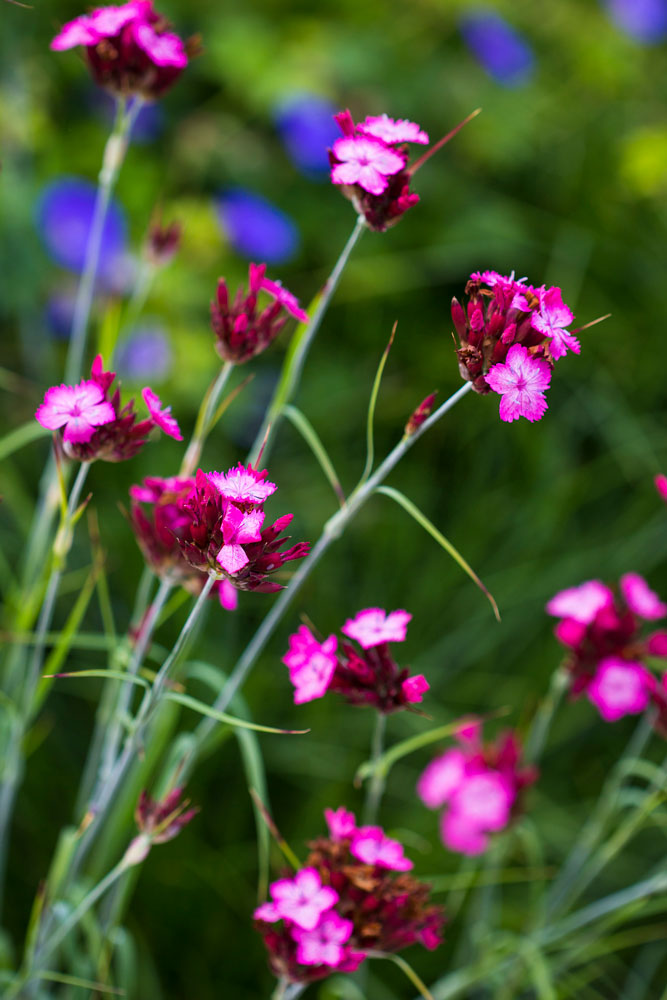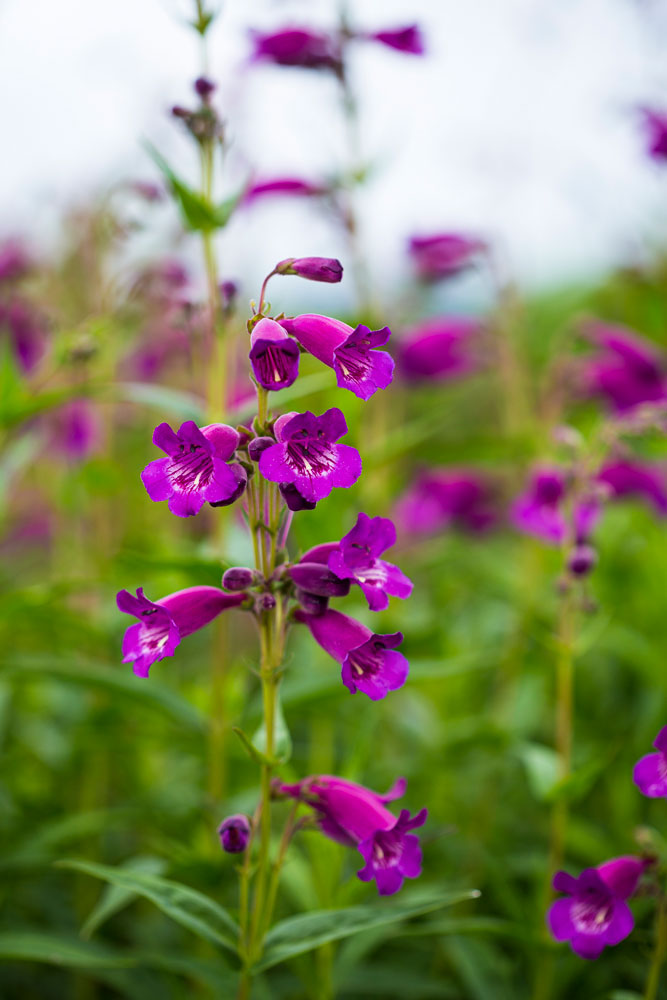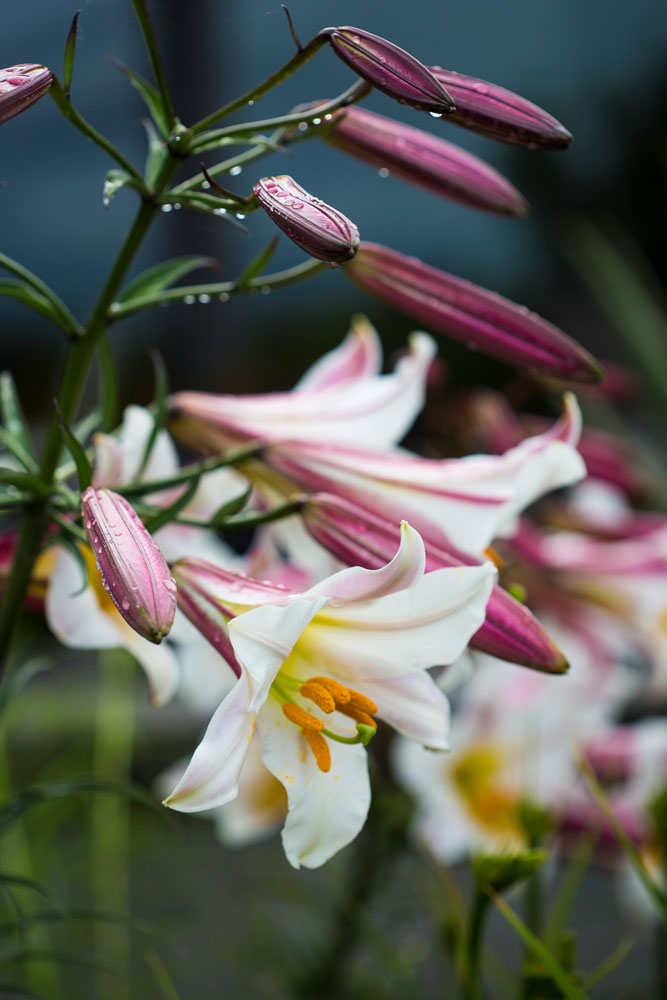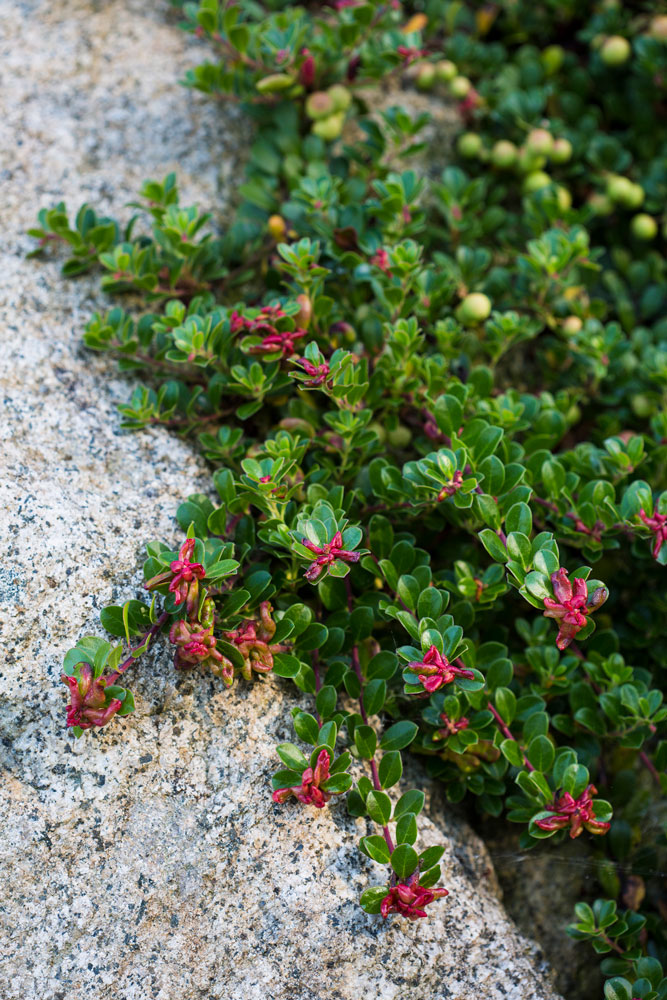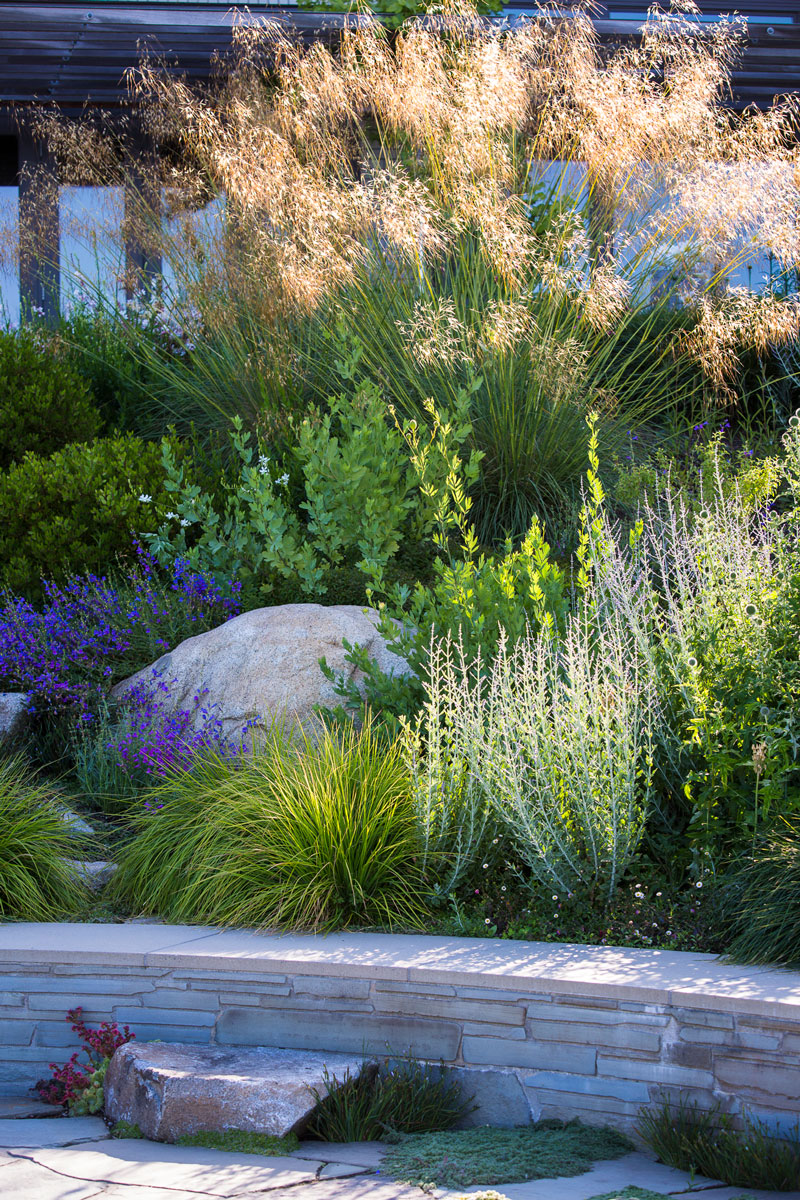
Healing the Shoreline
Nature-loving homeowners turn their garden into a wildlife sanctuary.
The results will surprise you.
SPRING 2016 | AUTHOR Thad Orr | PHOTOGRAPHY Claire Takacs | Garden Design Magazine
“Ducks will just hang out with people reading on the patio,” says Pam about her property located along Lake Washington near the city of Kirkland. “I’m a big naturalist. This is where my passion lies and I wanted my grades to reflect that.” Her backyard, which has more than 200 feet of shoreline, has become a safe zone for wildlife and a place for people to interact with nature.
Previously, the property was defined by a concrete bulkhead along the shore, a lawn, and a large sports court. The lawn sloped from the house down to the wall along the water. “It was a sort of cookie-cutter ‘golf course’ landscape,” Pam says. “It was appropriate when the grandkids were very young, but it was time for a change.”
The project started when Paul Broadhurst of Paul R. Broadhurst and Associates was working on the garden next door and noticed that the concrete bulkhead in Pam and her husband Al’s backyard was failing and brought it to their attention. It was good timing: A recent trip to Seattle’s Olympic Sculpture Park had gotten them thinking about a renovation.
“While walking along the park’s restored shoreline, Al and I met a group of marine biologists and had a long conversation about returning shoreline to its natural state and how every foot of the shore that can be turned into a native habitat is a worthwhile cause,” Pam says. “After hearing this, restoring our waterfront was already at the top of our minds. And once we began talking with Paul, we were all in.
“We knew we wanted a beach and more wildfire on the property, but that was about as far as we had taken in,” Pam says. So Broadhurst, who’s designed a number of restoration projects around Seattle, came up with several ideas to get the design process going: a restored shoreline, a meadow, a naturalistic pool. “But what worked so well was collaborating to discover what the property should become,” Pam says. “Paul came with his ideas and we came with ours.”
Much of the collaboration between the couple and Broadhurst happened over breakfast. Two to three times a month for the project’s duration, the team would get together over Pam’s homemade banana bread and coffee to discuss parts of the redesign in the progress, propose ideas, and get to know each other. “Some of my ideas were terrible,” Broadhurst says. “At one of these meetings I proposed a modern steel and wood bench that would sit along the beach. Al said no, it has to be organic.” Broadhurst wound up finding a fallen cedar tree on an expedition to Orcas Island, got permission to remove it, and worked with a local artisan to carve out a seat before transporting the bench to the property. “It turned out magnificently. Al was right,” Broadhurst says.
ABOVE The view from the upper terrace toward Lake Washington. The terrace is surrounded by plantings of purple Geranium ‘Rozanne’, white Lychnis coronaria ‘Alba’, and green foliage of daylilies. The sunken lower patio sits behind a berm of Roemer’s fescue and a riot of flowering perennials that provide shelter from lake breezes.
BELOW Before the remodel, the garden consists of a lawn, a sports court, and concrete bulkhead along the water. “It was sort of a golf course landscape,” says Pam, the property owner. “We knew we wanted a beach and more life here.”
“What worked so well was collaborating to discover what the property should become.”
Indeed, the aim of this project was to create an ecosystem for wildlife that happens to also accommodate people. The team eventually settled on a plan to break the property into distinct areas that make it easy for people and wildlife to coexist – some private and secluded, a few more playful, others designed to relax and enjoy vistas of the water. “I like to stroll to the shore and sit quietly on the log bench,” Pam says. “From there you can see fish, otter, ducks, and, at times, crayfish.”
Wanting to go beyond simply installing birdfeeders to create wildlife habitat, the team focused on selecting the right plants. “During this process I realized how much the wildlife depends on plants and access to cover for survival,” Pam says.
Broadhurst designed it this way. Drawing on ideas gathered while on local hikes with the homeowners, he recreated many of the regional habitats with a densely planted mix of natives and climate-appropriate plants designed to attract animal life. “We get bunnies making homes under dense shrubs,” Pam says. “The grasses, manzanitas, and perennials make great nesting grounds for birds. The plants also produce berries and seeds for the birds to eat.”
One of the many things I’ve learned from working with Broadhurst is that you don’t have to give up the non-native plants that you love to have a wild landscape,” Pam says. To mix the natural with more ornamental elements, Broadhurst created a transition from more free-flowing plantings of natives near the water to ornamentals composed for a more dramatic effect around the home. “There’s still space for my field of Japanese anemones,” Pam says. Her prized patch of anemones was placed along the upper terrace. The patch is 15 feet wide by 20 feet long, and the white blooms reach 3 to 5 feet in summer. “It’s spectacular and one of my favorite parts of the garden,” she says.
The most exciting area is around the pool at the center of the backyard. “It’s a crossroads – for plants, wildlife, and people,” Broadhurst says.
1. CREATE A CROSSROADS
The sunken flagstone patio that surrounds the pool is a crossroads for people and wildlife coming to and from the water. Circular walls provide extra seating. Plantings of yellow ‘Corky’ daylilies and ‘Takilma Gold’ Oregon sunshine along with Geranium ‘Rozanne’ surround the patio. Wooly thyme grows in the paving joints.
2. LET ELEMENTS INTERACT
The small 3/4-circle wading pool is a favorite place for young children to splash around. At only 8 inches deep, it doubles as a recirculation area for the water spilling from the vanishing edge pool. Broadhurst saw this as the design’s centerpiece, reflecting the interaction of straight lines with circles and curves that is so visible in Kandinsky’s Composition 8.
3. FIND IT IN THE WILD
Broadhurst found a fallen tree to use as a bench along the shoreline. After finding the log, he got permission to remove it, worked with local artisan Bill Dean of Raccoon Hollow Woodworks to carve a seat, and later placed it on the property.
4. BUILD WILDLIFE HABITAT
When designing, it helps to think about the land from the point of view of wildlife. They need the same things humans do: shelter, access to water, and food. Here, large stones, boulders, and fallen logs create living spaces for critters. Broadhurst planted directly into the water using hardstem bulrush that thrive along the water’s edge.
Nowhere are these interactions more visible than in the design of the pool. Here, the round forms of the granite boulders meet the clean lines of the black granite on the pool’s exterior lip, and flat plane of the vanishing edge surface. “I wanted it to feel like an alpine lake you might see in the High Sierras or the Cascades,” Broadhurst says.
A 7 feet, the pool is deep enough to accommodate kids jumping in from a specially placed boulder. “We didn’t even think about a pool initially, but when we brought it up to the grandkids their eyes lit up. My grandson recently had this 12th birthday here,” Pam says. “When we’re in the pool we often see Anna’s hummingbirds flying in to collect nectar from the California fuchsia planted just above the boulder retaining wall” – precisely the types of experiences Pam hoped the garden would facilitate.
The memories of creating the garden with Al, birthdays celebrated in the garden, seeing wildlife return to the land are what she values most. “While I was away, I loved getting a call from my grandson to tell me he woke up early and saw an otter roaming in the garden,” Pam says. “And I still remember the first time a mother duck and half a dozen ducklings followed me around the property and into the guesthouse. I was so happy that they felt comfortable enough to be with me. It was the most memorable experience I’ve had in the garden, because instead of just being an observer, I actually felt like I was a part of nature.”
1. CUSTOMIZE LIGHTING
Broadhurst designed all of the property’s lighting, fabricated by Tad Turner of T-Tech Welding & Fabrication in Woodinville, WA.
2. STAY SAFE
Stairs and walkways are fitted with metal railings custom designed by Broadhurst and fabricated by Turner. Pro tip: With three or more steps, there should be handrails.
3. FILL THE CRACKS
To soften paving, Sempervivum are tucked into spaces between rocks, paving, lighting, and wherever else they will grow.
4. LEAVE ROOM BETWEEN ROCKS
The rock work is tight enough for structural integrity, but Broadhurst left nooks to tuck in plants such as Asplenium trichomanes.
5. ADD ANGLES
A wood bridge over the pool leads to path by the lake; the angularity is fitting of the overall pool design, and the wood is a nod to shoreline dock.
6. MAKE TRANSITIONAL SPACES
This is where the natural (shoreline) meets manmade (pool), so its fitting that Carex flacca creeps up and onto the edge of the pool.
PLANT PICKS
DESIGNER PAUL BROADHURST’S SELECTIONS ARE A MIX OF DURABLE DENIZENS AND BRILLIANT BLOOMERS.
1 ARCTOSTAPHYLOS “HOWARD MCMINN”
A manzanita gardenworthy or its windswept, twiglike look and its smooth, dark-red bark. It thrives on low water and neglect but can survive pampering.
2 DIANTHUS CARTHUSIANORUM
Not your typical dianthus – it’s taller and has longer stems than most. This tall species with magenta flowers works well amongst Deschampsia ‘Goldtau’. Use sparingly in small drifts because its color is so bright.
3 GAURA “SNOW FOUNTAIN”
Gaura demands the loose freedom of meadow edges, where it can bend and sway in the wind with low grasses. Gauzy and diffuse it blooms from late spring into fall in this garden.
4 PENSTEMON ‘MIDNIGHT’
Deep-purple flowers grow on a plant that will reach 3 feet by 3 feet and bloom from spring through fall. Penstemon ‘Blackbird’ was also used in the garden.
5 LILIUM REGALE
A durable and persistent lily with white flowers that have a pinky-mauve reverse on 36- to 40-inch stems. This flower delivers a heady scent.
6 TRITELEIA LAXA ‘QUEEN FABIOLA’
A native that responds to spring rains with a burst of blue-purple blooms. Invaluable in meadows. Reflecting the region’s dry summers, it disappears by midsummer.
7 ERIOPHYLLUM LANATUM ‘TAKILMA GOLD’
This cultivar provides a long burst of clear yellow daisies against silvery leaves in spring. Extremely tough, it thrives in poor, gravelly conditions.
8 ARCTOSTAPHYLOS UVA-URSI ‘WOODS COMPACT’
Denser and smaller than the typical species, Broadhurst used it to flank stairways here, where you want a controlled growth rate and greater density.
9 SISYRINCHIUM ‘LUCERNE’
A quiet charmer, blue-eyed grass has deep-blue flowers that open fully only in the direct sun. “I make a point of seeing them in bloom,” Broadhurst says.


